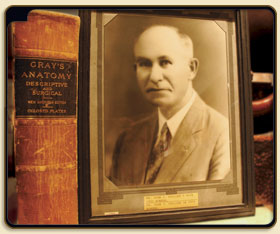|
The University of Texas System
 |
|
A photograph of Dr. John Shiller is flanked by his 1897 edition of Gray�s Anatomy.
|
Twenty-first century Texas is home to relentless growth and movement. Skyscrapers and superhighways dominate its sprawling cities. Across the state, the nine academic and six health institutions that comprise The University of Texas System educate more than 190,000 students to compete and thrive in a new, global economy.
So, what does John Jaroslav Shiller, a rural West Texas physician who once made house calls in a horse and buggy have to do with this fast-paced, modern state?
Far more than one would think.
Currently, the Shiller Endowment, which Dr. Shiller established for the UT System in his 1979 will, helps to educate 48 medical students and 55 undergraduates who will become the physicians, scientists, and healthcare workers of the 21st century.� In future years, the family�s $5 million planned gift will benefit even greater numbers of healthcare professionals.
John Shiller himself, who was born to Czech immigrant parents in 1877, attended The University of Texas Medical Branch at Galveston (then known as The University of Texas Medical School), until the devastation of the 1900 hurricane. After he graduated from Tulane Medical School in 1903, he became a small town doctor in rural Texas, eventually settling in the West Texas Czech community of Rowena, close to San Angelo. He and his wife Annie Louise reared a daughter, Pauline.
You can see the three of them at the Czech heritage museum, SPJST, in Temple. A small black-and-white photograph shows the three of them standing together in front of a house on the windswept prairie. Dr. Shiller is wearing the rounded brown Stetson, or one of its predecessors, that is now part of the museum�s Shiller exhibit.
Here, you can find the white glass cabinet and medical instruments he used in his office, where he charged a dollar for visits. You can see the syringes, bottles of medicine, and a library that includes a well-used 1897 edition of Gray�s Anatomy and volumes on chemistry, neurology, and infant nutrition.
Over his 56-year career from 1903 to 1959, Dr. Shiller once estimated he delivered 1,400 babies. When he made house calls, he traveled by horse and buggy, then by Model T. Rain turned the rural dirt roads into thick mud, where he occasionally became stuck.
�This is the phone he used,� says Sandi Wicker, the museum�s Executive Director. She holds up a large wooden box that weighs a good 40 pounds. �He�d attach the cord to his car battery and throw these wires over the telephone lines � and get service that way. It�s kind of the first car phone. Can you believe it?�
Predeceased by his wife, Dr. Shiller died in 1975 at the age of 98, leaving behind 1,500 acres of West Texas farmland. The Shillers� only child, Pauline, was 93 when she died in 2003.
Since Pauline was childless, the family left no direct descendants. The Shillers could have vanished along with memories of a rural state with dirt roads, doctors� house calls, and the worn leather bag Dr. Shiller always carried with him.
Instead, you can see their hard work and their generosity on display at a small Central Texas museum. You can see them, too, in the $5 million planned gift they left behind � benefiting new generations of physicians and scientists and keeping alive a tradition of service they once lived themselves. The ties between the country doctor born in the 19th century and his 21st century successors continue, much stronger than one might think.
The Shiller Endowment is invested in the Long Term Fund and had a market value of $5,738,024 as of August 31, 2007.
|